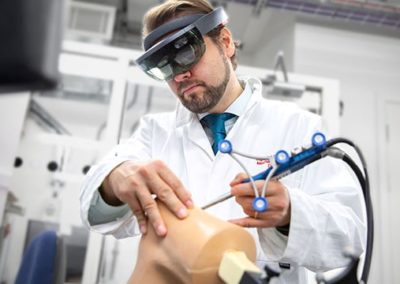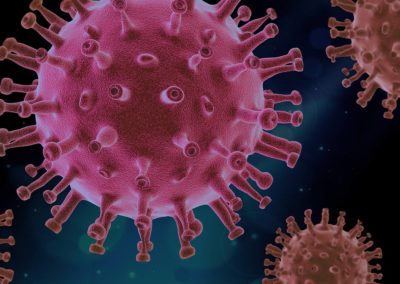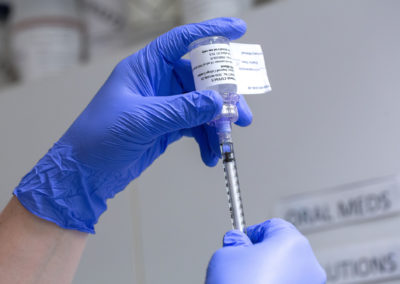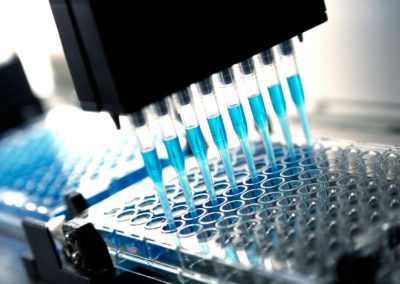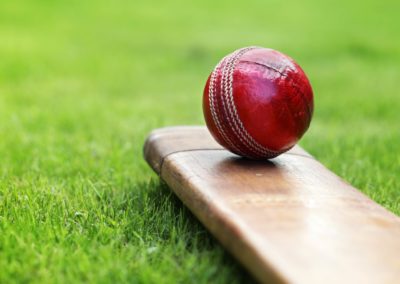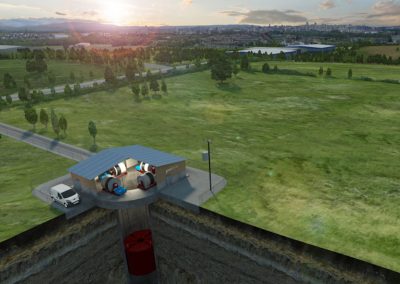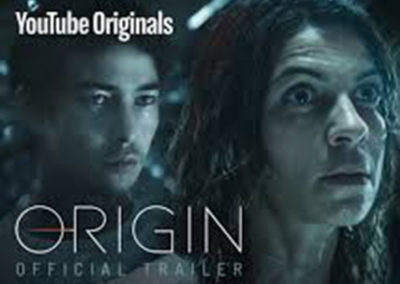Imperial’s world-class animal facility offers a wide range of in vitro and in vivo pre-clinical vaccine development and anti-infective testing capabilities. The highly experienced team can also provide protocol development, data analysis and ‘write up’ for publications.
The team, led by Dr John Tregoning, use well established animal models to provide effective read outs of vaccine or anti-infectives efficacy.
Animal challenges are carried out using human disease strains, instead of mouse-adapted strains, that may not be as translatable – plus well-validated immunogenicity assays are used to assess immune responses, which are interpreted by scientists with many years experience in immunology.

Our services
In vitro evaluation of anti-infectives
- Efficacy of anti-viral or anti-bacterial agents can be tested in vitro on our well- established assays allowing for quantification of bacterial or viral load post treatment.
- Assessment of minimum inhibitory concentrations (MIC) and determination of doses to be used in vivo.
Vaccine Protocol and Regimen Development
- Determination of frequency of dosing and interval length between doses
- Adjuvant selection
- Formulation of vaccine
- Vaccine stability testing at various temperatures
Vaccine and anti-infective agent efficacy determination via human disease challenge studies
- Well established and validated human disease mouse models:
| Viral pathogens: | Respiratory Syncytial Virus (RSV) |
| Seasonal influenza (multiple serotypes including H1, H3 and B) | |
| Bacterial pathogens: | Staphylococcus aureus (both MRSA and MSSA), |
| non-typeable Haemophilus influenzae (NTHI) | |
| Pseudomonas aeruginosa. |
- Vaccine and drug delivery via various routes that include: intramuscular, intranasal, intraperitoneal, subcutaneous, intradermal, oral gavage, tattooing and intravenous.
- In vivo observations of vaccine protection or drug responses including animal weight and clinical symptoms or pathology.
- Monitoring of immunogenicity readouts over course of vaccination or drug regimen.
Immunogenicity Assessment
- Variety of immunoassays for evaluation of both B and T cell responses.
- Custom Flow Cytometry panels to examine relevant cell types or immune cell activation and proliferation.
- Intracellular cytokine staining, ELISA or multiplex analysis of cytokines/chemokines produced.
- Evaluation of neutralising antibody activity.
- Viral titre or bacterial counts as readouts of protection or efficacy of anti-infective drugs.
- Histology and assessment of bronchoalveolar cellular infiltration.
We worked with Dr Tregoning to test our POD vaccine for immunogenicity and protection against influenza. This was as part of an Innovate UK funded study which was designed and developed in as a public-private partnership. We worked together to successfully deliver the project goals and we very happy with the high quality results produced by Dr Tregoning and his team who worked to the highest level. Working with Dr Tregoning and his team was an excellent experience.
CGS
Research partnerships include:
- Vaccibody (Norway) – DNA vaccines
- Novartis/GSK vaccines (Italy)
- Biontech (Germany) – RNA vaccines
- Altimmune (UK/USA) – analysis of material from human challenge
- IDRI (USA)
- Cell Guidance Systems (UK)
- Touchlight genetics (UK) – DNA vaccines
- Kymab – Bactericidal antibody development
- CGS – Protein Vaccine
- Edixomed: Anti-bacterial
- Cilian: Protein Vaccine
We worked with Dr Tregoning to test our vaccine constructs for protection against influenza. We worked closely together to design and plan the studies. The testing was rigorous and enabled us to compare the efficacy of a range of different vaccine constructs. We were very pleased with the results generated and they were subsequently published. We would recommend working with Dr Tregoning.
Vaccibody
Papers from interactions with biotech companies
- A.B. Vogel, L. Lambert, E. Kinnear, D. Busse, S. Erbar, K.C. Reuter, L. Wicke, M. Perkovic, T. Beissert, H. Haas, S.T. Reece, U. Sahin, J.S. Tregoning*. Self-amplifying RNA vaccines give equivalent protection against influenza to mRNA vaccines but at much lower doses. Molecular Therapy. 2018. Partner Biontech
- Gould VMW, Francis JN, Anderson KJ, Geroges B, Cope AV, Tregoning JS+. 2017. Nasal IgA Provides Protection against Human Influenza Challenge in Volunteers with Low Serum Influenza Antibody Titre. Frontiers in Microbiology. 8: 900. Partner Altimmune
- Laura Lambert, Ekaterina Kinnear, Jacqueline U. McDonald, Gunnveig Grodeland, Bjarne Bogen, Elisabeth Stubsrud, Mona M. Lindeberg, Agnete Brunsvik Fredriksen, John S. Tregoning+. 2016. DNA Vaccines Encoding Antigen Targeted To MHC Class II Induce Influenza Specific CD8+ T Cell Responses, Enabling Faster Resolution Of Influenza Disease. Frontiers in immunology. 7: 321. Partner Vaccibody
- E. Kinnear, L.J. Caproni, J. S. Tregoning+. 2015. A Comparison of Red Fluorescent Proteins to Model DNA Vaccine Expression by Whole Animal In Vivo Imaging. PLoS One. 10: e0130375. Partner Touchlight Genetics
- A.A. Walters, E. Kinnear, R.J. Shattock, J.U. McDonald, L.J. Caproni, N. Porter and J.S. Tregoning+. 2014. Comparative analysis of enzymatically produced novel linear DNA constructs with plasmids for use as DNA vaccines. Gene Therapy. 21:645-52. Partner Touchlight Genetics
Influenza
- H.T. Groves, J. McDonald, P. Langat, E. Kinnear, P. Kellam, C. Thompson, J. Ellis, J. McCauley, R. Elderfield, L. Parker, W. Barclay, J.S. Tregoning+. Mouse models of influenza infection with circulating strains to test seasonal vaccine efficacy. Frontiers in Immunology. 9: 126.
- A.B. Vogel, L. Lambert, E. Kinnear, D. Busse, S. Erbar, K.C. Reuter, L. Wicke, M. Perkovic, T. Beissert, H. Haas, S.T. Reece, U. Sahin, J.S. Tregoning*. Self-amplifying RNA vaccines give equivalent protection against influenza to mRNA vaccines but at much lower doses. Molecular Therapy.
- de Silva TI, Gould V, Mohammed NI, Cope A, Meijer A, Zutt I, Reimerink J, Kampmann B, Hoschler K, Zambon M, Tregoning JS. 2017. Comparison of mucosal lining fluid sampling methods and influenza-specific IgA detection assays for use in human studies of influenza immunity. Journal of Immunological Methods. 449:1-6
- Gould VMW, Francis JN, Anderson KJ, Geroges B, Cope AV, Tregoning JS+. 2017. Nasal IgA Provides Protection against Human Influenza Challenge in Volunteers with Low Serum Influenza Antibody Titre. Frontiers in Microbiology. 8: 900.
- McDonald JU, Zhong Z, Groves HT, Tregoning JS+. 2017. Inflammatory Responses to Influenza Vaccination at the Extremes of Age. Immunology. 151:451-63
- Laura Lambert, Ekaterina Kinnear, Jacqueline U. McDonald, Gunnveig Grodeland, Bjarne Bogen, Elisabeth Stubsrud, Mona M. Lindeberg, Agnete Brunsvik Fredriksen, J.S. Tregoning+. 2016. DNA Vaccines Encoding Antigen Targeted To MHC Class II Induce Influenza Specific CD8+ T Cell Responses, Enabling Faster Resolution Of Influenza Disease. Frontiers in immunology. 7: 321.
- J.F.S. Mann, J.S. Tregoning, Y. Aldon, R.J. Shattock and P.F. McKay. 2016. CD71 targeting boosts immunogenicity of sublingually delivered influenza haemagglutinin antigen and protects against viral challenge in mice. Journal of Controlled Release. 232: 75-82.
- R.F. Russell, J.U. McDonald, L. Lambert, J.S. Tregoning+. 2016. Use of the microparticle NanoSiO2 as an adjuvant to boost vaccine immune responses in neonatal mice against influenza. J. Virol. 90: 4735-44
RSV
- Ekaterina Kinnear, Laura Lambert, Jacqueline U. McDonald, Hannah M. Cheeseman, Lisa J. Caproni, John S. Tregoning+. 2017. Airway T cells protect against RSV infection in the absence of antibody. Mucosal Immunology. 11: 290
- IFN-γ from NK & T cells inhibit neonatal antibody. John S. Tregoning, Belinda Lei Wang, Jacqueline U. McDonald, YukoYamaguchi, James A. Harker, Michelle Goritzka, Cecilia Johansson, Alexander Bukreyev, Peter L. Collins, Peter J. Openshaw. Proceedings of the National Academy of Sciences Apr 2013, 110 (14) 5576-5581; DOI:10.1073/pnas.1214247110
- Harker JA, Yamaguchi Y, Culley FJ, Tregoning JS, Openshaw PJ. Delayed sequelae of neonatal respiratory syncytial virus infection are dependent on cells of the innate immune system. J Virol. 2014 Jan;88(1):604-11. doi: 10.1128/JVI.02620-13.
Non-typeable Haemophilus influenzae (NTHI)
- Siggins MK, Gill SK, Langford PR, Li Y, Ladhani SN, Tregoning JS. PHiD-CV induces anti-Protein D antibodies but does not augment pulmonary clearance of non typeable Haemophilus influenzae in mice. Vaccine. 2015 Sep 11;33(38):4954-61. doi: 10.1016/j.vaccine.2015.07.034.
Pseudomonas aeruginosa
- Mallia P, Webber J, Gill SK, Trujillo-Torralbo MB, Calderazzo MA, Finney L,Bakhsoliani E, Farne H, Singanayagam A, Footitt J, Hewitt R, Kebadze T, AniscenkoJ, Padmanaban V, Molyneaux PL, Adcock IM, Barnes PJ, Ito K, Elkin SL, Kon OM,Cookson WO, Moffat MF, Johnston SL, Tregoning JS. Role of airway glucose inbacterial infections in patients with chronic obstructive pulmonary disease. JAllergy Clin Immunol. 2017 Dec 13. pii: S0091-6749(17)31743-8. doi: 10.1016/j.jaci.2017.10.017.
- Gill, Simren K., Kailyn Hui, Hugo A. Farne, James Peter Garnett, Deborah L. Baines, Luke S. P. Moore, Alison H. Holmes, Alain Filloux and John S Tregoning. “Increased airway glucose increases airway bacterial load in hyperglycaemia.” Scientific reports (2016).
- Åstrand A, Wingren C, Benjamin A, Tregoning JS, Garnett JP, Groves H, Gill S,Orogo-Wenn M, Lundqvist AJ, Walters D, Smith DM, Taylor JD, Baker EH, Baines DL. Dapagliflozin-lowered blood glucose reduces respiratory Pseudomonas aeruginosa infection in diabetic mice. Br J Pharmacol. 2017 May;174(9):836-847. doi: 10.1111/bph.13741.
Pre-clinical vaccine development
- E. Kinnear, L.J. Caproni, J. S. Tregoning+. 2015. A Comparison of Red Fluorescent Proteins to Model DNA Vaccine Expression by Whole Animal In Vivo Imaging. PLoS One. 10: e0130375.
- A.A. Walters, E. Kinnear, R.J. Shattock, J.U. McDonald, L.J. Caproni, N. Porter and J.S. Tregoning+. 2014. Comparative analysis of enzymatically produced novel linear DNA constructs with plasmids for use as DNA vaccines. Gene Therapy. 21:645-52.
Advisory services
Product design, research methods, data analysis, technology evaluation for investment, technological innovation, patent evaluation, prototype and protocol development, policy, cyber security and more. Assisting museums, writers, film makers and artists to ensure creations scientifically sound.
Expert insight
Membership of Scientific Advisory Boards and Technical Panels, advice and guidance on drug development programmes, thought leadership, conference speakers, literature reviews and provision of foresight.
Analysis and testing
Use of the world-class specialist facilities and technicians at Imperial for projects ranging from aerodynamic measurements and medical imaging to structural testing and analysis.
Our consultants are world-leading experts in their field, committed to on-going research.
Who to contact:

Stephanie Cloots
Engagement Manager

